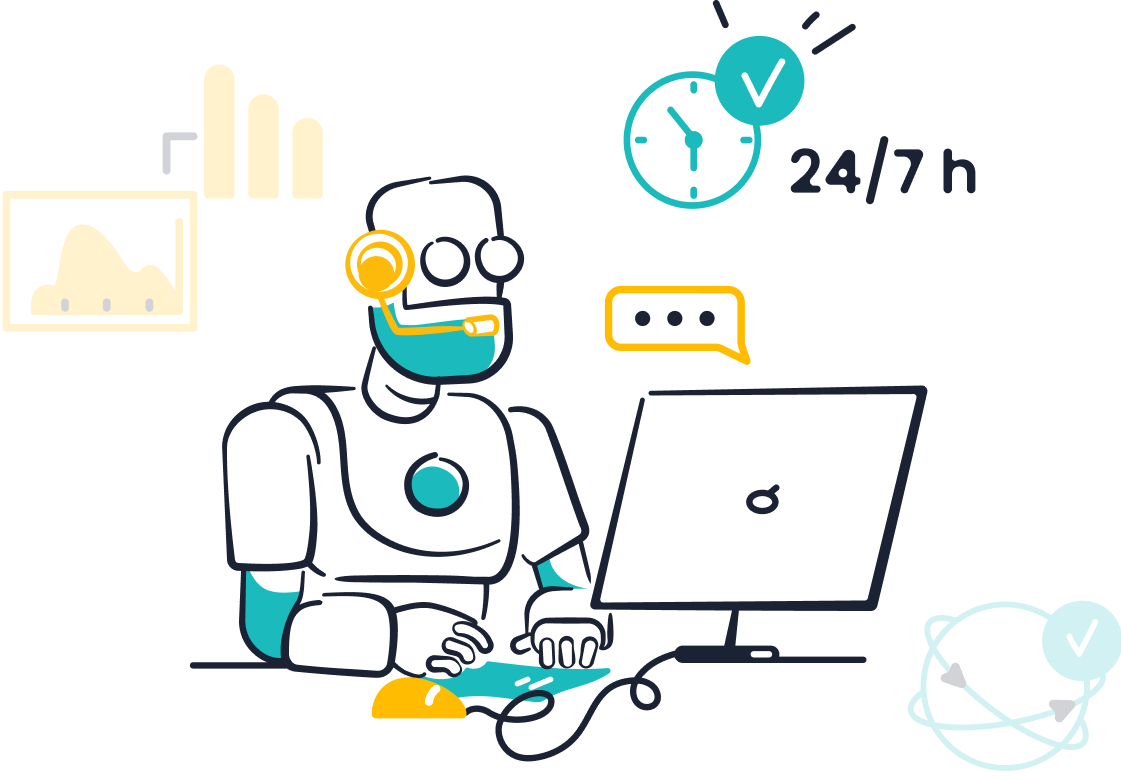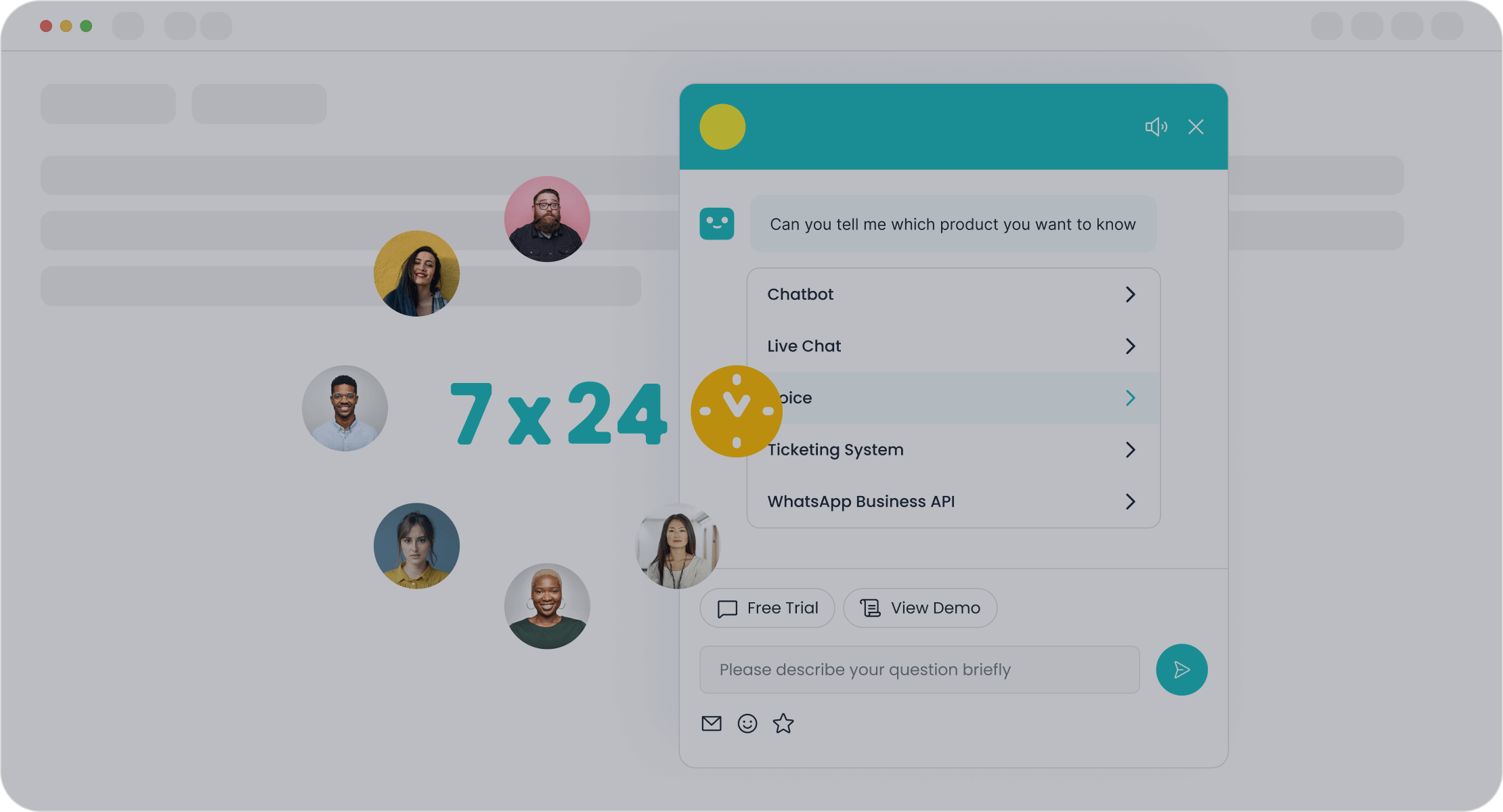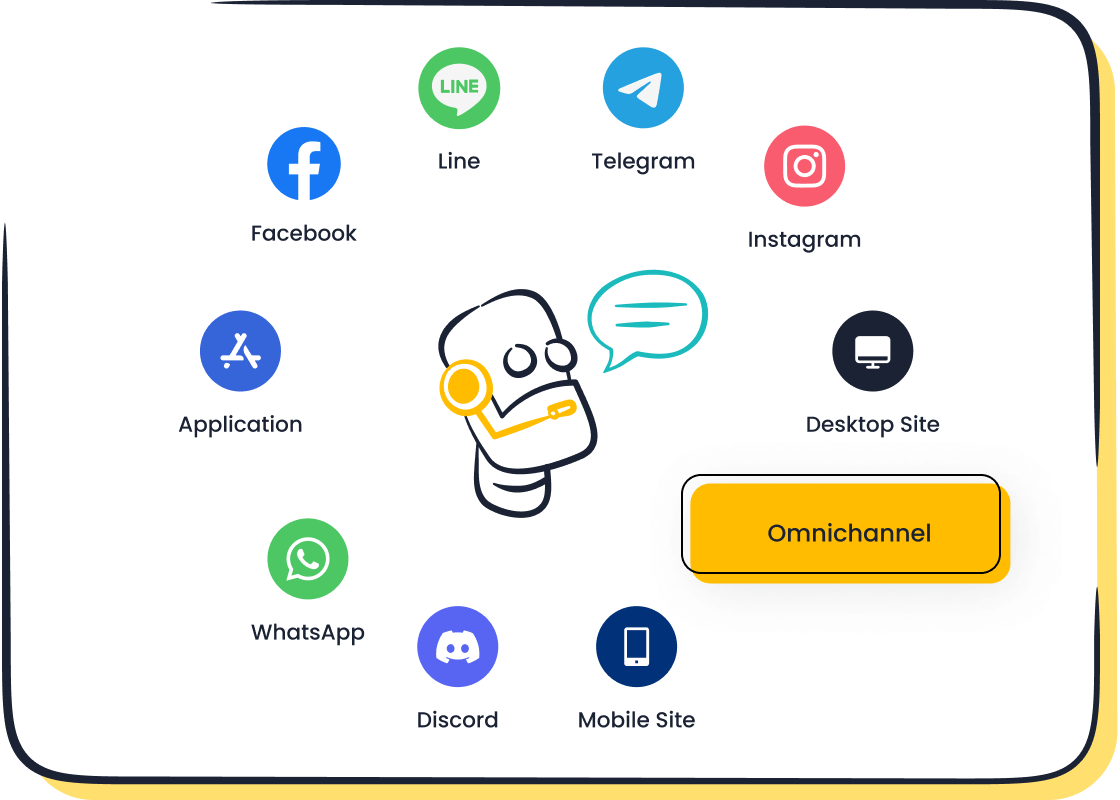AI challenges in customer service and their effects on businesses

AI is reshaping customer service, offering faster responses and round-the-clock availability. Businesses increasingly rely on AI, with 90% investing in its capabilities and 80% of retail companies planning adoption by 2025. This shift has transformed customer interactions, improving efficiency and even increasing average order values by 47%. However, understanding the disadvantages of AI in customer service is essential. Challenges like lack of empathy or errors in complex queries can frustrate customers. Addressing these issues ensures sustainable growth. Companies like Sobot demonstrate how AI can enhance customer experiences while maintaining operational efficiency.
Understanding AI in customer service

What is AI in customer service?
Definition and key features of AI in customer service
AI in customer service refers to the use of artificial intelligence technologies to enhance customer interactions, automate repetitive tasks, and improve overall efficiency. These systems rely on advanced tools like Natural Language Processing (NLP) and machine learning to understand customer queries, predict intent, and provide accurate responses. The market for AI in customer service is growing rapidly, valued at $308 million in 2022 and projected to exceed $3 billion by 2032. North America leads this growth, holding 48% of the market share, followed by Europe and Asia Pacific.

Key features of AI in customer support include 24/7 availability, multilingual capabilities, and the ability to personalize interactions. For example, Sobot's AI Chatbot operates around the clock, providing instant replies in multiple languages. It also uses a knowledge base to deliver accurate answers, improving productivity by 70% and cutting costs by up to 50%.
Common applications, including Sobot's Chatbot
AI in customer service has transformed how businesses interact with their customers. Common applications include chatbots, virtual assistants, and AI-driven ticketing systems. These tools handle tasks like answering FAQs, routing tickets, and conducting sentiment analysis. For instance:
- MindBridge uses AI to manage training requests and improve customer interactions.
- Lyro's chatbot learns over time, offering more human-like conversations.
- Generative AI solutions like ChatGPT automate processes, enabling 24/7 responses.

Sobot's Chatbot exemplifies these advancements. It autonomously resolves regular queries, assists agents, and integrates seamlessly with platforms like WhatsApp. This approach not only enhances customer satisfaction but also boosts conversions by 20%.
The role of AI in modern customer service
Automating repetitive tasks and improving efficiency

AI excels at automating repetitive tasks, freeing human agents to focus on complex issues. Chatbots and virtual assistants provide instant responses to common inquiries, reducing wait times and improving customer satisfaction. AI also supports agents by suggesting replies, summarizing conversations, and offering real-time guidance. For example, Sobot's Chatbot triages queries 24/7, saving businesses up to 50% on additional agent costs.
Machine learning algorithms further enhance efficiency by analyzing customer queries and predicting intent. This capability allows AI to prioritize requests and route them to the appropriate channels. Businesses using AI in customer support report significant cost savings and faster resolutions.
Enhancing availability and response speed
AI in customer service ensures round-the-clock availability, a critical factor in today's fast-paced world. Unlike human agents, AI systems never tire, providing consistent support at any time. Tools like Sobot's Chatbot operate across multiple channels, including SMS and WhatsApp, ensuring customers receive timely assistance wherever they are.
AI also improves response speed. Natural Language Processing enables systems to understand and process queries instantly. For example, AI call center solutions quickly route calls based on intent, enhancing the overall experience. With 95% of customer service leaders expecting bots to assist in interactions within three years, the role of AI in customer service automation will only grow.
Disadvantages of AI in customer service
Lack of human empathy
Challenges in building emotional connections with customers
AI systems lack the emotional intelligence needed to connect with customers on a personal level. While AI can process language and provide logical responses, it struggles to understand emotional nuances like tone, urgency, or frustration. This inability to empathize becomes a significant drawback in sensitive situations, such as resolving complaints or addressing emotionally charged issues. For example, a customer seeking support after a defective product experience may feel unheard when interacting with an AI system. The absence of human empathy can make customers feel undervalued, leading to dissatisfaction and a negative perception of the brand.
Examples of customer frustration with automation
Many customers express frustration when AI systems fail to meet their expectations. Common complaints include repetitive responses, irrelevant solutions, and the inability to escalate issues quickly. For instance, a customer trying to resolve a billing error might encounter an AI chatbot that misunderstands the query, forcing them to repeat the issue multiple times. This lack of human contact often leaves customers feeling ignored and dissatisfied. According to studies, emotionally complex queries frequently require human intervention, as AI cannot replicate the empathy needed to resolve such situations effectively.
Errors and limitations in understanding
Misinterpretation of customer queries and its consequences
AI systems often misinterpret customer queries, especially when faced with ambiguous or complex language. This risk of errors and misinterpretation can lead to irrelevant or incorrect responses, frustrating customers further. For example, a customer asking for "help with a refund" might receive instructions for initiating a return instead, due to the AI's inability to grasp the context. These mistakes not only delay issue resolution but also erode trust in the system.
Difficulties in handling complex or nuanced issues
AI struggles with complex or unique queries that require critical thinking or contextual understanding. While AI excels at handling straightforward tasks, it often fails to address nuanced problems effectively. Customers dealing with intricate issues, such as technical troubleshooting or multi-step processes, may find AI responses inadequate. This limitation forces businesses to rely on human agents for resolution, increasing operational costs and prolonging response times.
Privacy and security concerns
Risks of data breaches and misuse in AI systems
AI systems rely on vast amounts of customer data to function effectively, which raises significant privacy concerns. Data breaches can expose sensitive information, such as personal details or payment credentials, leading to identity theft or financial loss. A 2023 study revealed that 75% of consumers worry about AI's impact on privacy, while 63% fear that generative AI could expose their data to breaches. Companies must implement robust security measures to protect customer information and maintain trust.
Customer trust issues related to data handling
Transparency in data usage is critical for building customer trust. Many AI systems collect data without explicit consent, leaving users unaware of how their information is being used. Techniques like browser fingerprinting and hidden cookies exacerbate these concerns. Customers often feel uneasy about sharing personal information, especially when companies fail to communicate their data protection policies clearly. Addressing these privacy concerns and ethical questions is essential for businesses to ensure long-term customer loyalty.
High implementation and maintenance costs
Expenses associated with AI development and integration
Implementing AI in customer service requires significant financial investment. Businesses often face high initial costs when developing and integrating AI systems. These expenses include purchasing software, customizing solutions, and training employees to use the technology effectively. For example, deploying an AI voice agent in the healthcare sector can cost up to $430,000. Retail companies investing in AI sales call technology may spend as much as $1.2 million. These figures highlight the complexity of implementation and the financial burden it places on businesses.
The table below provides a clearer picture of these costs:
| Implementation Type | Initial Cost | Annual Maintenance Cost | ROI Timeframe |
|---|---|---|---|
| AI appointment setter (Insurance) | $175,000 | N/A | 9 months |
| AI voice agent (Healthcare) | $430,000 | N/A | N/A |
| AI sales call technology (Retail) | $1,200,000 | N/A | 1 year |
| Ongoing maintenance (general) | N/A | 15-22% of initial cost | N/A |
| Integration costs (general) | N/A | 25-40% of implementation budget | N/A |
| Human expertise (annual salary range) | N/A | $120,000 - $250,000 | N/A |
These costs can vary depending on the industry and the scale of the AI solution. Companies in traditional industries allocate 0.3-0.7% of their revenue to AI, while tech-focused businesses may invest up to 3%. High-performing organizations often dedicate 7-10% of their IT budgets to AI initiatives.
Ongoing costs for updates and troubleshooting
AI systems require continuous updates and maintenance to remain effective. These ongoing costs can add up quickly, making AI a long-term financial commitment. Businesses typically spend 15-22% of the initial implementation cost on annual maintenance. Additionally, integrating AI with existing systems can consume 25-40% of the original budget. Hiring skilled professionals to manage these systems further increases expenses, with salaries ranging from $120,000 to $250,000 annually.

For example, Sobot’s AI Chatbot offers a cost-effective solution by reducing service costs while maintaining high efficiency. However, even with such advanced tools, businesses must allocate resources for regular updates and troubleshooting to ensure optimal performance. Companies that fail to budget for these expenses may struggle to achieve a return on investment within the expected timeframe.
💡 Tip: To minimize costs, consider scalable AI solutions like Sobot’s Chatbot, which integrates seamlessly with existing platforms and reduces the need for extensive customization.
The impact of AI challenges on businesses

Customer satisfaction
Frustration caused by unresolved issues and lack of empathy
AI systems often fail to address customer needs effectively, leading to frustration. For example, when AI misinterprets queries or provides irrelevant responses, customers may feel ignored. This lack of empathy becomes especially problematic in emotionally charged situations. A customer seeking help with a defective product might feel undervalued if the AI cannot understand their urgency. Disjointed customer service experiences, where customers must repeat their issues across platforms, further amplify dissatisfaction. Companies that prioritize cost-cutting over quality by over-relying on AI risk alienating their audience. The table below highlights common issues that harm customer satisfaction:
| Issue | Description |
|---|---|
| Disjointed Customer Service Experiences | Customers often face fragmented support across different platforms, leading to repeated explanations and unresolved issues. |
| Cost-Cutting and Low-Quality Service | Companies prioritize cost savings by replacing staff with AI, resulting in poor service quality that harms customer loyalty and brand reputation. |
| Inadequate Tools for Customer Service Agents | Agents lack access to updated tools and data, leading to inefficiencies and customer dissatisfaction. |
| Over-Reliance on AI | Companies implement AI without a cohesive strategy, causing frustrating experiences and a lack of emotional connection with customers. |
Preference for human interaction in sensitive scenarios
Many customers prefer human interaction when dealing with sensitive issues. A March 2024 survey revealed that 81% of customers would rather wait to speak with a live person than interact with AI. This preference stems from AI's inability to provide empathy or adapt to complex emotions. For instance, a customer resolving a billing dispute may feel more reassured by a human agent who can understand their concerns. Businesses must recognize this preference and balance AI with human support to maintain a positive customer experience.
Brand reputation
Negative reviews and public perception due to AI errors
AI errors can significantly damage your brand's reputation. Customers often report feeling trapped in automated systems, which leads to frustration and negative reviews. Disjointed service experiences, where customers must navigate multiple channels and repeat their issues, further harm public perception. These challenges highlight the importance of addressing AI limitations to protect your brand image.
Loss of customer loyalty from poor experiences
Poor customer experiences caused by AI can erode loyalty. When customers encounter unresolved issues or feel undervalued, they are less likely to return. For example, rigid AI systems that fail to escalate issues to human agents can leave customers feeling ignored. This dissatisfaction often results in lost business and reduced lifetime value.
Operational efficiency
Downtime and inefficiencies caused by AI errors
AI errors can disrupt your operations, leading to inefficiencies. Many companies struggle to synchronize AI tools with existing systems, creating data silos and delays. For example, an AI chatbot integrated with outdated CRM systems may fail to provide accurate information. Misinterpretation of customer queries also contributes to inefficiencies. A customer asking about subscription cancellation might receive irrelevant details about changing plans, delaying resolution.
Increased reliance on human agents to address AI shortcomings
AI's limitations often increase your reliance on human agents. When AI systems fail to handle complex or nuanced issues, human intervention becomes necessary. This reliance can strain your resources and reduce operational efficiency. For instance, rigid AI systems that cannot adapt to new scenarios force agents to step in, increasing workloads and costs. Businesses must invest in scalable AI solutions, like Sobot's Chatbot, which integrates seamlessly with existing platforms to minimize inefficiencies.
Strategies to mitigate the disadvantages of AI in customer service
Blending AI with human support
Using AI for routine tasks and human agents for complex issues
You can address many challenges in customer service by combining AI with human expertise. AI excels at handling routine tasks like answering FAQs, routing tickets, or providing order updates. This allows human agents to focus on complex or emotionally sensitive issues that require empathy and critical thinking. For example, Sobot's Chatbot autonomously resolves repetitive queries, saving up to 50% on agent costs. Meanwhile, human agents step in for nuanced problems, ensuring a balanced and effective approach.
This strategy not only improves efficiency but also enhances customer satisfaction. Businesses like Telenor have successfully implemented conversational AI to handle account management tasks, while human agents manage escalations. This hybrid model ensures customers receive timely and empathetic support when needed.
Sobot's Chatbot as an example of effective human-machine collaboration

Sobot's Chatbot demonstrates how AI and human agents can work together seamlessly. It operates 24/7, handling multilingual queries across platforms like WhatsApp and SMS. By resolving 70% of routine inquiries, it frees agents to focus on more complex tasks. OPPO, a leading smart device company, achieved an 83% chatbot resolution rate and a 94% positive feedback rate by integrating Sobot's solutions. This collaboration highlights how blending AI with human support can transform customer service.
Improving AI transparency
Informing customers when they are interacting with AI systems
Transparency builds trust. Informing customers when they are engaging with AI systems helps set clear expectations. You can achieve this by labeling AI interactions or providing disclaimers during conversations. Studies show that 65% of customer experience leaders view transparency as essential for AI adoption. When customers know they are interacting with AI, they are more likely to appreciate its capabilities and limitations.
Building trust through clear data usage policies
Customers value their privacy. Clearly communicating how you handle their data fosters trust and loyalty. For instance, 75% of businesses believe that a lack of transparency could lead to customer churn. You should outline your data collection and usage policies in simple terms. This approach not only reassures customers but also demonstrates your commitment to ethical AI practices.
Regularly updating and testing AI systems
Ensuring accuracy and reliability in AI operations
Regular updates and testing keep AI systems accurate and reliable. You should monitor performance continuously to identify errors and make necessary adjustments. For example, a SaaS provider used AI-driven testing to achieve 90% test coverage within hours, reducing bugs by 30%. This proactive approach ensures your AI delivers consistent and dependable customer service.
Addressing potential biases in AI algorithms
AI systems can unintentionally develop biases, leading to unfair outcomes. Regular testing helps identify and mitigate these biases. By using diverse training data, you can improve AI's ability to handle nuanced customer interactions. This ensures your AI operates fairly and inclusively, enhancing customer satisfaction and trust.
The future of AI in customer service
Balancing automation and human touch
The importance of maintaining a human connection in customer service
In customer service, maintaining a human connection is vital for building trust and loyalty. While AI offers speed and efficiency, it often lacks the warmth and empathy that customers value. For example, a chatbot can quickly answer questions about store hours, but it may struggle to comfort a frustrated customer dealing with a billing issue. This gap highlights the need for human agents to handle emotionally charged or complex situations. Businesses that prioritize this balance often see stronger relationships with their customers. Studies show that companies excelling in customer experience grow revenue 4%-8% faster than their competitors. By blending AI with human interaction, you can ensure both efficiency and meaningful connections.
Trends in hybrid customer service models, including Sobot's solutions
Hybrid customer service models are becoming the norm. These models combine AI for routine tasks with human agents for more nuanced issues. For instance, Sobot's Chatbot handles repetitive queries 24/7, freeing agents to focus on complex problems. This approach not only improves efficiency but also enhances customer satisfaction. A company using this model reported a 94% positive feedback rate, demonstrating its effectiveness. By 2025, AI is expected to manage 95% of customer interactions, but the human touch will remain essential for fostering loyalty. Businesses adopting hybrid models can meet rising customer expectations while maintaining a personal touch.
Innovations to address current challenges
Advances in emotional AI to improve customer interactions
Emotional AI is transforming customer service by enabling systems to understand and respond to emotions. Tools like sentiment analysis gauge the tone and urgency of queries, allowing AI to provide more appropriate responses. For example, if a customer expresses frustration, the system can escalate the issue to a human agent. Generative AI also enhances sentiment analysis, helping businesses monitor feedback in real-time. These advancements address one of AI's biggest challenges—its lack of empathy. As emotional AI evolves, it will play a key role in improving customer interactions and satisfaction.
Enhanced security measures for AI systems
Security remains a top concern in AI-driven customer service. Innovations like advanced encryption and real-time monitoring are helping businesses protect customer data. Intelligent routing systems also ensure sensitive issues reach the right agents securely. For example, AI-powered chatbots now use secure protocols to handle payment information, reducing the risk of breaches. These measures not only safeguard data but also build trust. With 64% of business owners believing AI will enhance customer relationships, investing in robust security is essential for the future of AI in customer service.
AI has revolutionized customer service, but its limitations, such as lack of empathy and errors in complex queries, can negatively impact customer satisfaction and operational efficiency. For instance, an AI system failing to recognize the urgency of an internet outage highlights the need for human intervention in critical situations. While AI excels at automating repetitive tasks, human agents remain essential for handling nuanced issues and building trust. Studies show that 30% of customers over 40 prefer human interaction, emphasizing the importance of balancing AI with human support.
To overcome these challenges, businesses should adopt hybrid models that combine AI's efficiency with human empathy. Sobot's Chatbot exemplifies this approach by resolving routine queries while allowing agents to focus on complex problems. This strategy not only enhances customer satisfaction but also ensures sustainable growth. By addressing AI's limitations and leveraging advanced tools like Sobot's solutions, you can create a more adaptable and customer-centric service experience.
FAQ
What are the main challenges businesses face when implementing AI in customer service?
Businesses often encounter high costs, technical complexities, and customer concerns about data privacy. For example, integrating AI systems like Sobot's Chatbot requires upfront investment but offers long-term savings by automating repetitive tasks and improving efficiency.
How does AI impact jobs in customer service?
AI can lead to potential job displacement by automating routine tasks. However, it also creates opportunities for human agents to focus on complex issues. For instance, Sobot's Chatbot handles repetitive queries, allowing agents to provide personalized support.
Can AI fully replace human agents in customer service?
AI cannot fully replace human agents due to its limitations in empathy and handling complex issues. A hybrid approach, like Sobot's solutions, combines AI for routine tasks with human agents for nuanced problems, ensuring better customer satisfaction.
How can businesses address job displacement fears caused by AI?
You can address job displacement fears by reskilling employees and adopting hybrid models. For example, Sobot's Chatbot enhances efficiency without eliminating the need for human agents, creating a balanced workforce.
Is AI secure enough for handling sensitive customer data?
AI systems like Sobot's Chatbot prioritize security with advanced encryption and real-time monitoring. Businesses must implement robust measures to protect customer data and maintain trust.
See Also
Transforming Support Through AI-Powered Customer Service Agents
Enhancing Efficiency With AI-Driven Customer Service Solutions
Ten Strategies to Improve Live Chat Customer Experience